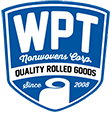 Filtration systems have relied primarily on conventional media like woven fabrics and metal meshes for years. More recently, nonwoven filtration media has emerged as a preferable alternative for many applications and industries, offering a host of unique advantages.
Filtration systems have relied primarily on conventional media like woven fabrics and metal meshes for years. More recently, nonwoven filtration media has emerged as a preferable alternative for many applications and industries, offering a host of unique advantages.
In choosing the right filter media for a process or filter product, it is helpful to understand the differences, benefits, and limitations of both conventional and nonwoven types of filtration media. Specifying the right materials and customizing them to suite the specific application conditions is the key to success.
Understanding Conventional Filtration Media
Conventional or traditional filtration media refers to materials that have been considered the standard for filtration applications. These include woven fabrics, fiberglass, and metal mesh. The structure of these materials often involves interwoven fibers or strands that create a grid or matrix, allowing liquids or air to pass through while trapping particulate matter.Examples of conventional filtration media:
- Woven textiles – fabrics made of cotton, polyester, or nylon
- Metal mesh – stainless steel or other metal grids used in high-temperature applications
- Fiberglass media – common in HVAC systems and industrial air filtration
Nonwoven Filtration Media Offers an Alternative
Nonwoven filtration media is unique in that it consists of fibers that are bonded together mechanically, thermally, or chemically, without being woven into a fabric. The result is a more flexible, durable, and often more efficient filtration material. Nonwoven media offers higher particle retention, better flow rates, and longer life cycles in many cases.Examples of nonwoven filtration media:
- Meltblown fabric – used in face masks and air filters due to its fine filtration capabilities
- Spunbonded polypropylene – commonly found in HVAC systems and medical products
- Needlepunched felts – popular in industrial filtration, like dust collection systems
Key Differences Between Conventional and Nonwoven Filtration Media
| Criteria | Conventional Filtration Media | Nonwoven Filtration Media |
|---|---|---|
| Filtration Efficiency | Larger pores or openings, resulting in lower efficiency for fine particulate filtration. | Higher filtration efficiency due to the random fiber arrangement, ideal for fine particles. |
| Durability and Lifespan | Robust, especially in high-temperature or corrosive environments, but may clog easily. | Highly durable with a longer lifespan and reduced clogging, requiring fewer replacements. |
| Airflow and Pressure Drop | Thicker structure or tighter weave can impede airflow, causing a higher pressure drop. | Allows for higher airflow rates and lower pressure drops, improving energy efficiency. |
| Cost-Effectiveness | Higher upfront costs, but offers longevity in reuse applications. | Lower initial cost, and more cost-effective over time due to longer lifespan and lower energy use. |
Choosing the Right Filtration Media for Your Industry
Selecting between conventional and nonwoven filtration media depends largely on the specific needs of the application. Below are some examples of industries and their preferred choices:Oil and Gas
- Conventional Media – Metal mesh filters are still a staple due to their ability to withstand harsh conditions and high temperatures.
- Nonwoven Media – Used increasingly in refining processes and air filtration, where finer particulate capture is essential.
Pharmaceutical and Healthcare
- Nonwoven Media – The preferred choice for high-efficiency particulate filtration, ensuring cleanroom environments remain sterile and preventing cross-contamination.
Food and Beverage
- Conventional Media – Woven fabric filters are often used in liquid filtration processes to remove large solids.
- Nonwoven Media – Nonwoven materials are becoming more popular for beverage filtration due to their fine filtration capabilities.
HVAC Systems
- Nonwoven Media – Increasingly favored for the capture of fine dust, allergens, and microorganisms while maintaining airflow and reducing energy costs.
Conclusion
Both conventional and nonwoven filtration media have their advantages, depending on the industry and application. Understanding the unique strengths of each type of media can help buyers make informed decisions that improve process efficiency, product quality, and operational costs.Nonwoven filtration media offers high efficiency and customizable solutions for air, liquid, and specialty filtration needs. Nonwovens can be tailored for specific applications and enhanced with treatments like antimicrobial or flame retardant properties.
WPT Nonwovens provides versatile options with superior performance and efficiency, along with our outstanding application support and customer service. Please contact us to discuss how we may serve your needs as a U.S. supplier of nonwovens.
